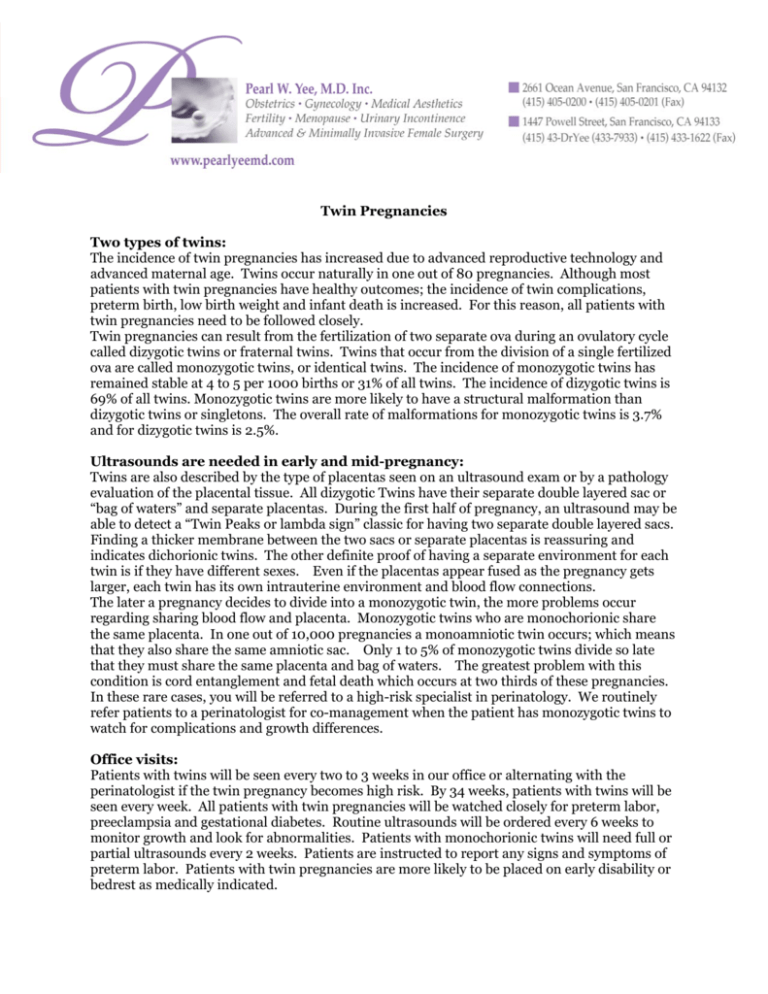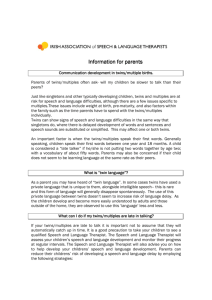Twin Pregnancies - Pearl W. Yee, MD
advertisement

Twin Pregnancies Two types of twins: The incidence of twin pregnancies has increased due to advanced reproductive technology and advanced maternal age. Twins occur naturally in one out of 80 pregnancies. Although most patients with twin pregnancies have healthy outcomes; the incidence of twin complications, preterm birth, low birth weight and infant death is increased. For this reason, all patients with twin pregnancies need to be followed closely. Twin pregnancies can result from the fertilization of two separate ova during an ovulatory cycle called dizygotic twins or fraternal twins. Twins that occur from the division of a single fertilized ova are called monozygotic twins, or identical twins. The incidence of monozygotic twins has remained stable at 4 to 5 per 1000 births or 31% of all twins. The incidence of dizygotic twins is 69% of all twins. Monozygotic twins are more likely to have a structural malformation than dizygotic twins or singletons. The overall rate of malformations for monozygotic twins is 3.7% and for dizygotic twins is 2.5%. Ultrasounds are needed in early and mid-pregnancy: Twins are also described by the type of placentas seen on an ultrasound exam or by a pathology evaluation of the placental tissue. All dizygotic Twins have their separate double layered sac or “bag of waters” and separate placentas. During the first half of pregnancy, an ultrasound may be able to detect a “Twin Peaks or lambda sign” classic for having two separate double layered sacs. Finding a thicker membrane between the two sacs or separate placentas is reassuring and indicates dichorionic twins. The other definite proof of having a separate environment for each twin is if they have different sexes. Even if the placentas appear fused as the pregnancy gets larger, each twin has its own intrauterine environment and blood flow connections. The later a pregnancy decides to divide into a monozygotic twin, the more problems occur regarding sharing blood flow and placenta. Monozygotic twins who are monochorionic share the same placenta. In one out of 10,000 pregnancies a monoamniotic twin occurs; which means that they also share the same amniotic sac. Only 1 to 5% of monozygotic twins divide so late that they must share the same placenta and bag of waters. The greatest problem with this condition is cord entanglement and fetal death which occurs at two thirds of these pregnancies. In these rare cases, you will be referred to a high-risk specialist in perinatology. We routinely refer patients to a perinatologist for co-management when the patient has monozygotic twins to watch for complications and growth differences. Office visits: Patients with twins will be seen every two to 3 weeks in our office or alternating with the perinatologist if the twin pregnancy becomes high risk. By 34 weeks, patients with twins will be seen every week. All patients with twin pregnancies will be watched closely for preterm labor, preeclampsia and gestational diabetes. Routine ultrasounds will be ordered every 6 weeks to monitor growth and look for abnormalities. Patients with monochorionic twins will need full or partial ultrasounds every 2 weeks. Patients are instructed to report any signs and symptoms of preterm labor. Patients with twin pregnancies are more likely to be placed on early disability or bedrest as medically indicated. Timing and Type of delivery: The overall average age of delivery for all twin pregnancies is 35.4 weeks. Premature twins have more complications from anatomic or functional immaturity of such as: temperature control, respiratory problems, patent ductus arteriosus, hypoglycemia, intraventricular hemorrhage, necrotizing enterocolitis, infection and retinopathy of prematurity. Except for respiratory problems, the outcomes after treating these problems in twins is similar to singleton pregnancies. Most of the complications are caused by abnormal growth from placental insufficiency. Small twin babies usually outgrow the discrepancies by 6 to 17 years of age. The main risks occur in discordant twins who have a greater than 15% difference in weight. The larger the percentage difference between the weight of the twins, a higher the risk of fetal or neonatal deaths from prematurity, congenital anomalies and twin-twin transfusion syndrome. The twin-twin transfusion syndrome occurs in 15% of monochorionic diamniotic twins. Patient showing discordant growth become a high-risk pregnancy and will be referred to a perinatologist for co-management, regular antepartum testing, and serial ultrasounds. All patients with monochorionic twins who have symmetrical growth with perfect antepartum testing results and no complications will be referred to a perinatologist for recommendation for delivery at 36 weeks. Studies have shown that even with perfectly symmetrical growth of both twins there is a 5% spontaneous intrauterine death rate for pregnancies beyond 36 weeks with monochorionic twins. Patients with dizygotic twins with similar weights generally have excellent outcomes. By the time a mother reaches 38 weeks of gestation, we will offer an elective induction of labor if both twins are directed heads downward. Unless medically indicated, an elective induction at 37 weeks would need a preinduction amniocentesis to assess for lung maturity. We do not recommend for any twin pregnancy to reach beyond 39 weeks of gestation; which is considered postdates for a twin. Studies have shown that second twins have a higher incidence of perinatal mortality when delivered vaginally. The incidence of needing an emergency cesarean section for the second twin after delivery of the first is 24%. The absolute risk of death due to anoxia for second twins at term is 1/350 twin births. For this reason, we recommend that unless the twins are both positioned head down; we schedule patients for a cesarean delivery. Vanishing twin: Single fetal death is common in early pregnancy; occurring in 3.3% of first trimester pregnancy. Nutrition: Patients with twin pregnancies need 300 kcal per day more than a patient with a singleton pregnancy. Patients with twins need to consume 600 kcal a day more than a nonpregnant patient. Pregnant patients with twins are recommended to gain a total of 35 to 45 pounds at term or 1.5 pounds per week after 20 weeks gestation. The need for additional iron supplementation will be guided by blood testing. Daily prenatal vitamins will be recommended that include omega-3 fatty acids. All pregnant patients should consume 1 mg a day of folic acid in their diet and or supplements. Patient education handout/OB: Twins updated December 2007 by Pearl Yee M.D. Inc.







